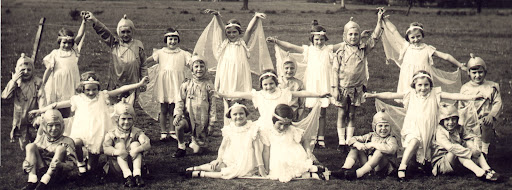 |
| Yorkshire Square Eight |
My last post created some nostalgia for village community life, now remembered only vaguely. Little remained beyond the nineteen-fifties. Much of what we know is second-hand.
I could have said so much more. Pre-television, pre-car-ownership, pre-eating out, pre-foreign holidays, people created their own entertainment. There were dances, a drama group, a music and opera society, and sports teams.
I remember the annual fairs on the village green, which my grandma oddly called the village “Fe-ast”, when parts of larger fairs stopped off on their travels around the country, possibly on the way to Hull Fair. The loud piping of fairground organs, the ring of slot machines, the smell of saucy hot dogs, the colour and blur of the rides, the force of bumping cars (dodgems), swings, roundabouts, rifles with rigged sights, brightly coloured wooden ducks swirling through torrents of water, excited voices, all above the hum of diesel generators, still take me back there, to the age of six or seven.
Then there were the village carnivals, maybe not every year, fading away by my day. So much time, energy, organisation and creativity went into them. There was real talent in the village. The costumes were particularly impressive.
The 1937 carnival programme named more than 150 participants, mainly children. Proceedings opened with a procession of Heralds, The Lord Chamberlain, the Crown bearer, Standard bearers and Pages, and the crowning of the May Queen. The Queen was presented with a bouquet, and her Courtiers and Maids of Honour received representatives of Britannia, England, Ireland, Scotland, Wales and Peace.
The main proceedings consisted of children’s dances. There was a Yorkshire Square Eight, Butterfly dancers, Milkmaids and Boy Blues, Spring Flower dancers, a nursery rhyme medley, Indians and Palefaces, Fairies and Elves, Sailors hornpipe and signals, and Jockeys. There were two maypole dances, the first creating a single plait and gypsy tent, the second a double plait, spider’s web and barber’s pole. Later there were larger group dances: a Circassian Circle and a “Mage on a Cree”. The day ended with a march led by the Queen, her Court and a band of toy soldiers. No doubt there were other adult activities well into the evening. I don’t have the pages naming the organisers. Nor do I know how the music was provided, or who designed and made the costumes.
The programme lists the names of my mother, her brother and sister, and many of her “cousins” and friends. She danced in the Yorkshire Square Eight (above, top row, left). Her cousin, Jean, is in front of her. Jean would later lose a son in an awful railway accident. Another cousin, Alfie, is third from the right on the top row. Her friend, Kitty, is fourth from the right on the bottom row. I went with my mother to watch the Coronation on their television.
Mother’s brother was an elf (below, top row, third from left). Her sister was a milkmaid (second picture below, top row, fourth from left). Her sister was the only one of four siblings to live to a good age. Other cousins and relatives appear in these pictures, too.
 |
| Fairies and Elves |
 |
| Milkmaids and Boy Blues |
What does any of it matter now? The kids aren’t bothered. And those earlier children were soon to be shaken from their idyll, violently thrown into today’s world of conflict and events in far away lands. My uncle, the little boy in the elf outfit, died overseas on National Service in a tragic air force accident at only twenty-three. I can just remember him. He was clever; a plumber. He would have done well in the building boom. His widow, astonished that after sixty-five years without contact I still called her “Aunty R”, told me how she had arrived back on the bus from work to be told the awful news by my grandfather. My poor grandfather, who had lost all his own siblings when young, and now a son. And his own father would have told him how he was only one of two out of eleven to live beyond their thirties, their names and dates recorded carefully in the family bible. It was all so long ago. It’s just nostalgia.



